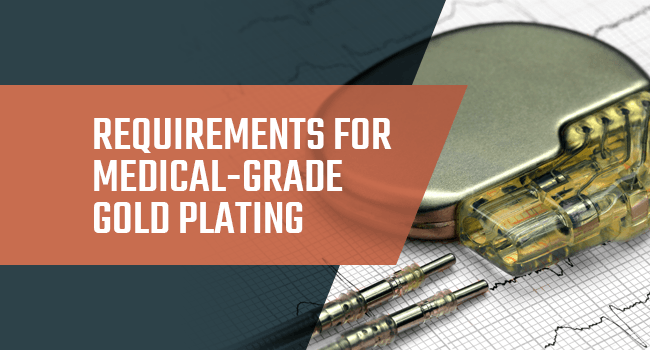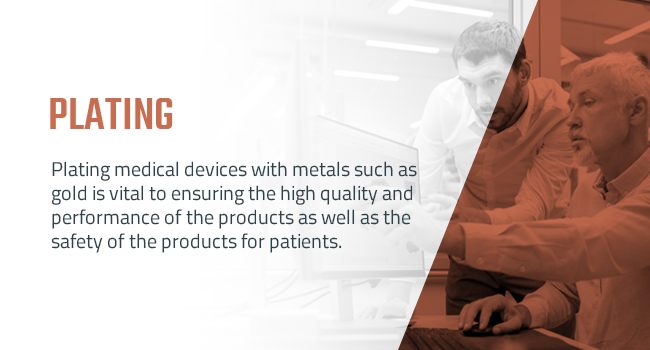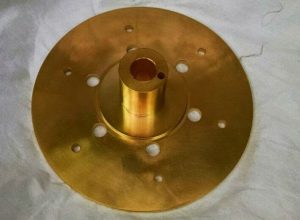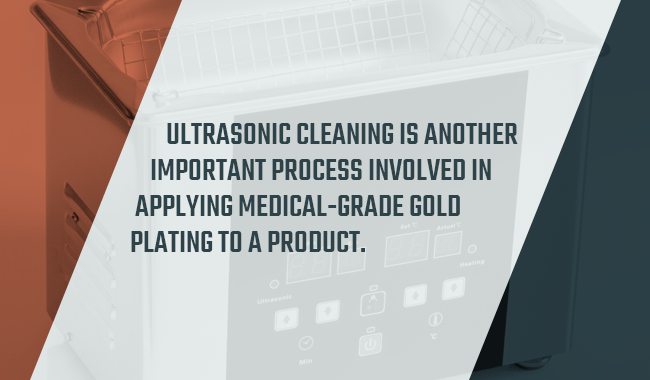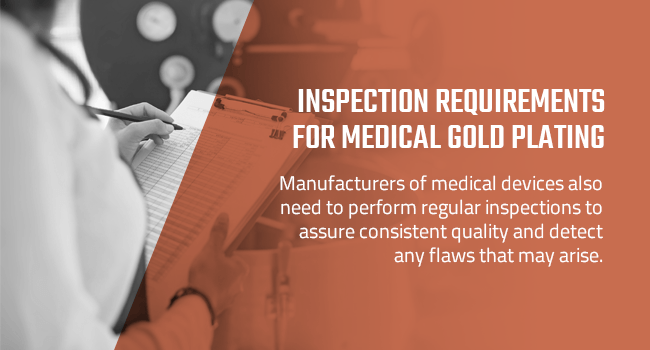Overview:
| Requirements | Ultrasonic Cleaning | |
| Plating | Rinsing, Drying and Packaging | |
| Tooling | Inspection Requirements | |
| Request Quote |
Metal plating is crucial for many different kinds of medical devices, as it improves the quality, performance and safety of these tools, implants and other objects. It can enhance sanitation, biocompatibility, corrosion resistance, strength and many other aspects of medical devices.
The medical sector uses various kinds of metal, but gold is one of the most popular choices. Some of the most common applications of medical device gold plating include stents, pacemakers, dental implants, battery casings, suture rings and more.
Beneficial Medical Characteristics of Gold
Gold features numerous characteristics that make it a viable alternative for medical use. Gold is biologically benign, meaning it won’t cause a negative reaction when coming in contact with internal organs and other areas of the human body. It is also unaffected by oxygen, moisture or ordinary acids, so it offers superior resistance against corrosion of metal appliances placed inside the body. And despite its inherent hardness, gold is an extremely malleable metal that can be easily shaped to develop high-precision medical instruments and devices.
Because of the safety issues associated with medical devices, you must follow some specific requirements for medical-grade electroplating. It’s essential that your work is up to all of the relevant standards and adheres to all safety rules. That’s why it’s important to choose a reliable plating company that has experience with medical-grade plating and commits to following all associated requirements.
Understanding these requirements can help you design better medical products and choose the right plating company for your projects. This guide will explain more about them.
Requirements
Standards play an important role in ensuring that gold plating processes for medical devices meet the relevant specifications. These standards include:
1. ASTM B488
ASTM B488 establishes requirements for gold coating used in engineering applications to improve resistance to corrosion and tarnishing, solderability, bondability, contact resistance and infrared reflectivity.
The standard classifies gold coatings into three types based on characteristics such as minimum purity and four graded codes based on Knoop hardness. Complying with this standard requires testing the plating to confirm that it meets these specifications as well as requirements for thickness, mass per unit area, adhesion, ductility, integrity and appearance.
ASTM B488 minimum purity types:
- Type I designates 99.7 percent minimum purity
- Type II designates 99.0 percent minimum purity
- Type III designates 99.9 percent minimum purity
Codes for hardness as measured on the Knoop hardness scale:
- Code A designates a maximum Knoop hardness of 90
- Code B designates a Knoop hardness of 91 to 129
- Code C designates a Knoop hardness of 130 to 200
- Code D designates a Knoop hardness of greater than 201
It also includes various classes for minimum thickness ranging from 0.25 to 5 micrometers.
2. AMS 2422
AMS 2422 is another standard that’s specific to gold plating. It covers engineering specifications for the electrodeposition of gold as well as the properties of the gold plating. It’s frequently used in the aerospace sector but also has applications in the medical industry.
This standard requires a minimum gold purity of 99 percent. The thickness of the plating cannot be less than 0.00005 inches on every functional surface.
3. MIL-G-45204
MIL-G-45204 is another similar specification. This military specification covers gold plating electrodeposited onto metallic surfaces, such as may be used in the healthcare field.
Like ASTM B488, this standard provides designations for several types based on purity. It also contains requirements for several grades based on Knoop hardness and classes based on minimum thickness.
MIL-G-45204 minimum purity types:
- Type I designates 99.7 percent minimum purity
- Type II designates 99.0 percent minimum purity
- Type III designates 99.9 percent minimum purity
Hardness grades:
- Grade A designates a maximum Knoop hardness of 90
- Grade B designates a Knoop hardness of 91 to 129
- Grade C designates a Knoop hardness of 130 to 200
- Grade D designates a Knoop hardness greater than 201
Minimum thickness classes:
- Class 00 must have a minimum thickness of .00002 inch
- Class 0 must have a minimum thickness of .00003 inch
- Class 1 must have a minimum thickness of .00005 inch
- Class 2 must have a minimum thickness of .00010 inch
- Class 3 must have a minimum thickness of .00010 inch
- Class 4 must have a minimum thickness of .00030 inch
- Class 5 must have a minimum thickness of .00050 inch
- Class 6 must have a minimum thickness of .00150 inch
4. MIL-DTL-45204
MIL-DTL-45204 is another military specification for gold plating that’s electrodeposited on metallic surfaces.
This specification provides requirements for purity, hardness and minimum thickness as well.
MIL-DTL-45204 minimum purity types:
- Type I designates 99.7 percent minimum purity
- Type II designates 99.0 percent minimum purity
- Type III designates 99.9 percent minimum purity
Hardness grades:
- Grade A designates a maximum Knoop hardness of 90
- Grade B designates a Knoop hardness of 91 to 129
- Grade C designates a Knoop hardness of 130 to 200
- Grade D designates a Knoop hardness greater than 201
- Class 00 must have a minimum thickness of .00002 inch
- Class 0 must have a minimum thickness of .00003 inch
- Class 1 must have a minimum thickness of .00005 inch
- Class 2 must have a minimum thickness of .00010 inch
- Class 3 must have a minimum thickness of .00010 inch
- Class 4 must have a minimum thickness of .00030 inch
- Class 5 must have a minimum thickness of .00050 inch
- Class 6 must have a minimum thickness of .00150 inch
Plating
Plating medical devices with metals such as gold is vital to ensuring the high quality and performance of the products as well as the safety of the products for patients. The gold plating process needs to be reliable to ensure that the resulting product meets all medical-grade plating requirements.
Electroplating is one of the most prevalent and effective methods for coating devices in this way, as it produces consistent results. The metal finishing company can also control the process to create the results needed for each project.
The electroplating process involves placing the substrate — the object to be plated — on or in a device and then submerging it into an electrolytic solution that contains dissolved ions of metals. If gold plating is desired, the solution will contain gold ions. After immersing the object, you introduce an electric current into the solution that deposits the ions onto the substrate.
There are two types of electroplating you may use — barrel plating and rack plating. The best method for a project depends on the desired outcome.
Barrel plating, as the name implies, involves placing the substrate in a barrel-shaped cage and submerging it in the electrolyte solution. The barrel is made of an electrically non-conductive material, while metals wires put into each end of the barrel conduct the current that causes the ions to deposit. The barrel undergoes a tumbling motion, which helps create a uniform coating. This method is best used for small objects. One advantage of the barrel method is that you can plate multiple small objects at one time.
Rack plating involves attaching the substrate to a rack using metal hooks or bands and then placing it in the electrolyte solution. You then introduce the electric current through the metal hooks or bands. Rack plating is ideal for larger, complex or delicate parts.
Examples of Gold Plating in the Medical Field
Typical gold plating applications in the medical field include:
- Production of electronic pacemakers to regulate a patient’s heartbeat, as well gold-plated stents used to inflate and support arteries
- Implants where minimizing the risk of infection is vital, such as those used to aerate the inner ear’s tympanic cavity — thanks to gold’s biocompatibility.
- Procedures by surgeons that clear clogged coronary arteries and remove tumors
- Sealing of life-threatening injuries and wounds through emergency physicians’ and battlefield medics’ use of lightweight lasers that implement gold-plated contacts
- Manufacturing of false teeth, caps and crowns in dentistry
Tooling
There are many different kinds of tools you can use during the plating process to achieve your desired results. The devices you use play an integral role in creating the correct result.
1. Horizontal Barrel
For barrel plating, the horizontal barrel is the standard. This device is a horizontal barrel-shaped container that rotates throughout the plating process. The barrel has holes in it that must be small enough that parts will not fall through or get stuck in the wall of the barrel.
Horizontal barrels are useful because they can handle larger volumes and a larger variety of workloads than other types of barrels. They can range in size from around 17 cubic feet to miniature, portable barrels.
2. Oblique Barrel
Oblique barrels sit on an angle, have a more open design and feature a less intense tumbling action. This type of barrel is ideal for smaller workloads.
3. Vibratory Barrel
Vibratory barrels, which came originally from the Swiss watch industry, use mechanical vibratory energy rather than tumbling during the plating process to move the substrates over an electrode bed. This method is useful for more intricate projects, such as when you need to plate onto small inner diameters.
4. Plating Rack
A plating rack is a metal rack that you attach substrates to using metal hooks, bands, screws, spring fingers or other methods. The substrate stays in a fixed position in the plating solution. Rack plating is ideal for parts that are larger, more complex or too delicate for tumbling in a plating barrel.
At Sharretts Plating Company, we build nearly all of our own barrel and rack plating equipment, which gives us the flexibility to complete a wide range of products. Using custom-built tools allows us to plate everything from single, small prototypes to large-scale, mass-production projects.
Ultrasonic Cleaning
Ultrasonic cleaning is another important process involved in applying medical-grade gold plating to a product. This extremely powerful technique uses sound waves to thoroughly clean an object.
You should apply ultrasonic cleaning to a substrate before plating onto it, and you can also use it during rinsing, drying and packaging phases. It’s ideal for cleaning delicate parts with small, intricate features, and it’s very effective for cleaning shop dirt and debris as well as cutting oil from a part’s surface. It’s especially useful for parts that have interior cavities and blind holes.
Ultrasonic cleaning involves the use of aqueous cleaners or solvents and an external transducer that unit creates high-frequency sound waves. These waves cause tiny bubbles to form on the part’s surface. When they get to a certain size, these bubbles will implode. These implosions happen at a microscopic scale but involve a lot of pressure — enough to increase the effectiveness of the cleaning solution considerably.
You can use various types of generators, including piezoelectric and magnetostrictive, ones. You can also choose from a wide range of solvents and cleaners. The right one for the job will depend primarily on the materials that make up the part. You can also combine ultrasonic cleaning with other, more traditional cleaning methods.
Importance of Proper Rinsing, Drying and Packaging
It’s critical to keep the parts clean after the plating process is complete, as this is critical to patient safety and the proper performance of the product. You can use various tactics for rinsing, drying and packaging parts to ensure that they stay free of contamination until they’re delivered to the end users.
Rinsing is a critical step for ensuring the cleanliness of a piece after plating. Proper rinsing removes contamination and increases the part’s joinability through soldering, laser welding, wire bonding or other methods. Rinsing is especially crucial for small parts. You can use various methods for rinsing including ultrasonic deionized water rinses, water counter-flow rinses and spray rinses.
After rinsing, you must ensure that the product is completely dry. One common method for drying is using a stainless steel oven that has been thoroughly cleaned and operates in a controlled environment. This helps make sure that any water left on the item’s surface evaporates entirely.
The packaging process for gold-plated medical devices must also be subject to stringent requirements for cleanliness. One useful tactic for maintaining the purity of the gold deposit is nitrogen bag packaging, which keeps the parts in an inert nitrogen atmosphere until they are ready for use. You accomplish this by placing the item in a bag, extracting the air from within the bag and then replacing it with nitrogen before heat-sealing the pack. The removal of all air prevents oxidation of underplating from occuring inside the package.
Inspection Requirements for Medical Gold Plating
Manufacturers of medical devices also need to perform regular inspections to assure consistent quality and detect any flaws that may arise. This ensures that each product performs as expected and can be used safely.
Various tools and methods can be helpful in the inspection process. Visual inspections can help catch more obvious problems, while more precise methods are needed to spot minute inconsistencies in gold plated parts. One technique for these inspections is x-ray spectrometry, which allows you to measure deposit thickness without disturbing or damaging it. ASTM B568 provides specifications for conducting these tests.
You can also perform adhesion testing under magnification. You can use one or more of various test methods to try to separate the coating from the substrate to test its adhesion. Doing these tests under magnification allows you to spot any small failures. Tests that are appropriate for gold plating include the bend, chisel/knife, file, heat/quench and peel tests, according to ASTM B571.
Sharretts Plating Company Can Handle All Your Gold Plating Needs
Sharretts Plating Company has the experience, equipment and expertise necessary to produce gold-plated medical devices and components that meet all relevant requirements. With SPC, you can be sure you’ll get a high-quality, safe product every time. We also build the vast majority of our plating equipment, which decreases costs for our customers and enables us to complete a broad range of projects to the exact specifications needed.
Request Quote
To learn more about our medical-grade gold plating services and how we can help you with your next plating project, request a free, no-obligation quote from us today.


